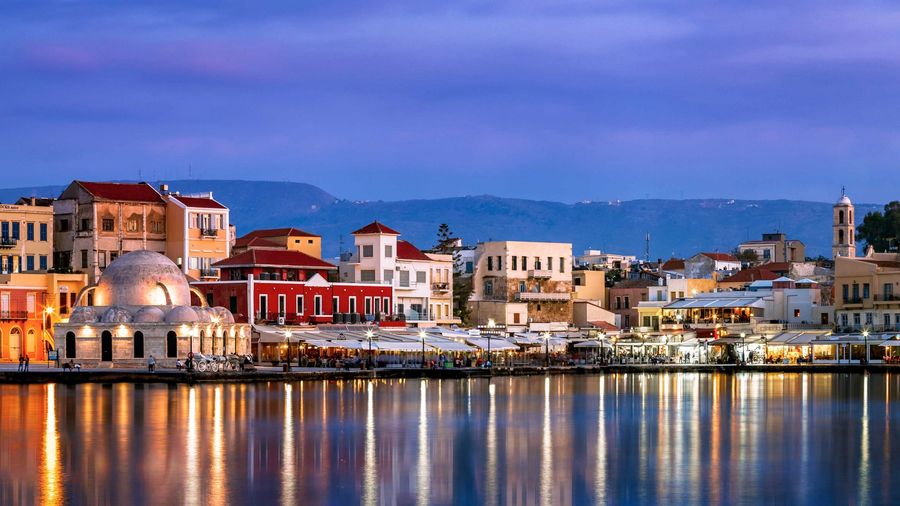
Chania
Nestled on the northwest coast of Crete, Chania is a captivating city where rich history, vibrant culture, and stunning natural beauty come together. As one of Crete’s most picturesque and historically significant cities, Chania invites visitors to wander through its charming streets, explore ancient ruins, and soak in the atmosphere of its bustling harbor. With influences from the Minoans, Venetians, and Ottomans, Chania is a melting pot of cultures that offers a truly unique experience for travelers seeking both history and relaxation.
Chania’s history stretches back over 5,000 years, beginning with the Minoan civilization, the earliest advanced civilization in Europe. The ancient city of Kydonia, located where modern-day Chania now stands, was a major center of Minoan culture. Over the centuries, Chania came under the rule of several great powers, including the Romans, Byzantines, Venetians, and Ottomans, each leaving their mark on the city’s architecture and culture.
During the Venetian period (1204-1669), Chania developed into a prosperous trading center, and much of the city’s old town reflects the Venetian influence, with grand mansions, narrow streets, and an iconic harbor. After the Venetians, the Ottomans took control, adding elements like mosques and hammams to the cityscape. Today, Chania is a vibrant city that embraces its diverse heritage while offering a warm and welcoming atmosphere to visitors from around the world.
Top 5 Unique Characteristics of Chania
1. The Venetian Harbor
The Venetian Harbor is the heart of Chania and one of its most iconic landmarks. Built by the Venetians in the 14th century, the harbor is lined with colorful buildings, bustling cafes, and traditional tavernas, offering a perfect blend of history and modern-day charm. At the harbor’s entrance stands the Chania Lighthouse, one of the oldest lighthouses in the world and a symbol of the city. A walk along the harbor, especially at sunset, is a must-do for any visitor, providing stunning views of the sea and the city’s old town.
2. Old Town and the Jewish Quarter (Evraiki)
Chania’s Old Town is a maze of narrow, cobblestone streets filled with Venetian mansions, Ottoman architecture, and hidden courtyards. The Jewish Quarter, or Evraiki, is one of the most fascinating parts of the Old Town, where you can visit the restored Etz Hayyim Synagogue, which dates back to the 15th century. This area offers a glimpse into the multicultural history of Chania, where different religions and communities lived side by side for centuries. Exploring the Old Town is like stepping back in time, with each turn revealing new historical gems.
3. The Archaeological Museum of Chania
Located in a former Venetian church, the Archaeological Museum of Chania is a treasure trove of artifacts from Crete’s long and varied history. The museum’s exhibits cover the Minoan, Hellenistic, Roman, and Byzantine periods, showcasing pottery, sculptures, jewelry, and everyday objects that tell the story of Chania’s past. One of the highlights is the collection of Minoan pottery and the impressive Roman mosaic floors. A visit to this museum offers a deeper understanding of Chania’s historical significance and the island’s cultural heritage.
4. Balos Lagoon and the Beaches
Just a short distance from Chania, the breathtaking Balos Lagoon offers one of the most stunning beach experiences in Greece. Known for its crystal-clear turquoise waters, soft white sand, and dramatic landscape, Balos is a favorite spot for both locals and visitors. Chania’s nearby beaches, such as Elafonissi and Falassarna, are equally famous for their natural beauty. These beaches are ideal for swimming, snorkeling, or simply relaxing in the sun, and they showcase the pristine, unspoiled nature that Crete is known for.
5. The Cretan Cuisine and Local Markets
Chania is known for its rich Cretan cuisine, which is celebrated for its fresh ingredients, local herbs, and healthy Mediterranean flavors. Traditional dishes like dakos, Cretan cheeses, stifado, and kalitsounia (savory pastries) are must-tries when visiting the city. The Chania Municipal Market (Agora), located in the city center, is the perfect place to sample local delicacies, buy fresh produce, and experience the vibrant atmosphere of a traditional Greek market. The food culture in Chania is deeply connected to its land and history, making every meal a celebration of Cretan traditions.
Chania Today: A Hub of Culture and Nature
Today, Chania is a lively and cosmopolitan city that attracts travelers from all over the world. Its unique blend of history, culture, and natural beauty makes it one of the most popular destinations in Crete. Visitors can spend their days exploring ancient ruins, relaxing on stunning beaches, or enjoying local cuisine at a seaside taverna. The city’s friendly atmosphere and warm hospitality ensure that everyone feels at home.
Chania is also a gateway to Crete’s stunning natural landscapes, including the Samaria Gorge, one of Europe’s longest gorges, and the White Mountains, offering opportunities for hiking and outdoor adventures.
Fun Facts About Chania
The ancient city of Kydonia, located beneath modern Chania, was one of the most important cities of the Minoan civilization.
Chania Lighthouse, originally built by the Venetians, was rebuilt by the Egyptians in the 19th century, giving it a unique architectural style.
Chania is home to the Cretan Diet Festival, which celebrates the island’s healthy, traditional cuisine with food tastings, cooking workshops, and cultural events.
The Etz Hayyim Synagogue in Chania is the only surviving Jewish synagogue on Crete, having been restored after World War II.
Chania’s harbor was used as a filming location for the movie Zorba the Greek, starring Anthony Quinn.
Whether you’re drawn by its ancient history, its scenic harbor, or its delicious cuisine, Chania offers an unforgettable experience for travelers seeking both adventure and relaxation in one of Greece’s most beautiful cities.